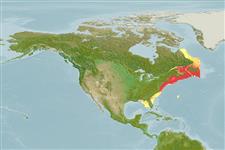Classification / Names
Common names from other countries
Main reference
Size / Weight / Age
Max length : 30.0 cm TL male/unsexed; (Ref. 7251); common length : 20.0 cm TL male/unsexed; (Ref. 2702)
Length at first maturity
Lm 12.0 range ? - ? cm
Environment
Marine; brackish; benthopelagic; oceanodromous (Ref. 51243); depth range 15 - 420 m (Ref. 58426), usually ? - 55 m (Ref. 53006)
Climate / Range
Subtropical, preferred 20°C (Ref. 107945); 62°N - 26°N, 87°W - 52°W
Distribution
Short description
Dorsal
spines
(total): 3;
Anal
spines: 3. This species is distinguished by the following characters: body oval to somewhat elongate, moderately deep (its depth 2.7 to 3 times in total length) and strongly compressed; eye medium-sized (its diameter 3.4 to 3.7 times in head length), surrounded by a small area of adipose tissue; snout short and blunt, lower jaw projecting somewhat beyond upper; mouth small, tip of maxillary not reaching to anterior eye margin; teeth in jaws very small, in a single row, while those in the upper jaw flattened and with 3 tiny cusps; dorsal and anal-fin bases very long (about equal in length), the anterior fin rays elevated, but fins not falcate, and both fins preceded by 3 short, weak, spines; caudal fin deeply forked; pectoral fins long (longer than head) and pointed; pelvic fins absent; a conspicuous series of 17 to 25 pores along anterior half of body under dorsal fin; lateral line high, following dorsal profile; scales small, present also on cheeks; caudal vertebrae 17 to 20; body color pale blue above, silvery below; numerous irregular dark spots on sides in live fish (fading after death) (Ref. 53006).
IUCN Red List Status (Ref. 115185)
Threat to humans
Harmless
Human uses
Fisheries: commercial; gamefish: yes
Tools
Special reports
Download XML
Internet sources
Estimates of some properties based on models
Phylogenetic diversity index
PD50 = 0.5078 many relatives (e.g. carps) 0.5 - 2.0 few relatives (e.g. lungfishes)
Trophic Level
3.9 ±0.0 se; Based on diet studies.
Resilience
High, minimum population doubling time less than 15 months (K=0.8(?); tm=1)
Vulnerability
Low vulnerability (21 of 100)
Price category
